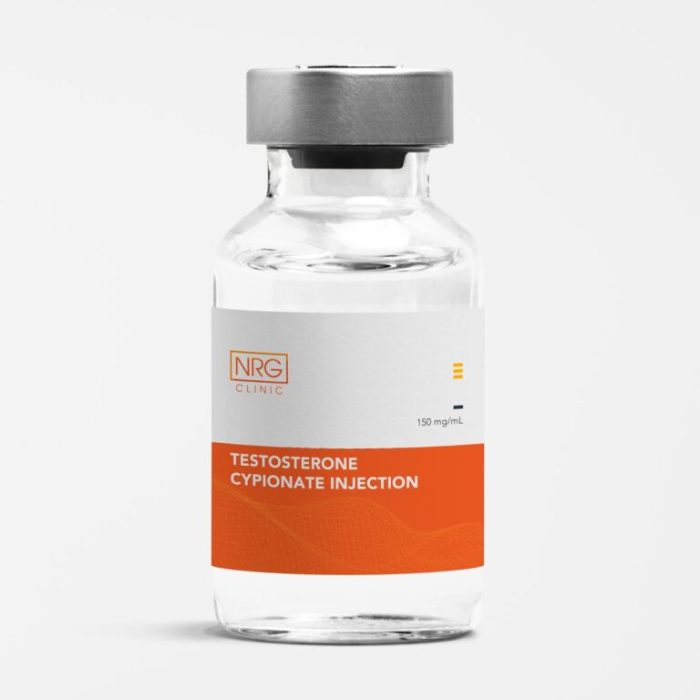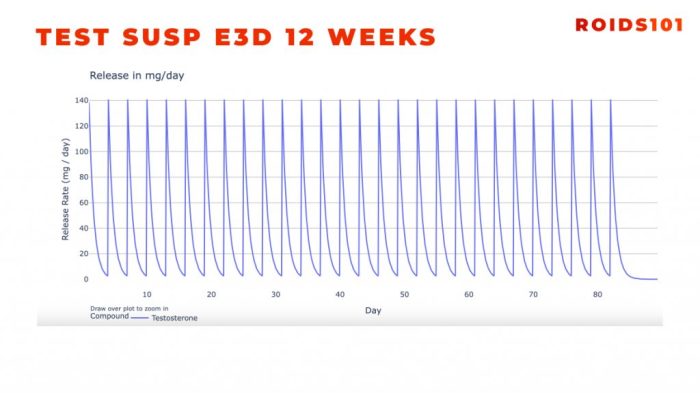Testosterone cypionate vs enanthate is a crucial comparison for anyone interested in hormone therapy. These two testosterone esters, while both serving the same purpose, differ significantly in their release rates and pharmacokinetic profiles. Understanding these nuances is key to choosing the right option for individual needs and ensuring optimal results.
This comprehensive look delves into the chemical structures, pharmacokinetic differences, clinical applications, potential benefits and risks, dosage, and administration of both testosterone cypionate and enanthate. We’ll explore how these factors influence the effectiveness and safety of each ester, providing a detailed comparison to guide informed decisions.
Introduction to Testosterone Esters

Testosterone, a crucial male sex hormone, plays a vital role in various bodily functions, including muscle growth, bone density, and libido. However, the body’s natural release of testosterone is often insufficient for desired outcomes, particularly in bodybuilding or other performance-enhancing contexts. To address this, synthetic testosterone esters are used, offering a controlled release over time. Two common esters are cypionate and enanthate, differing in their chemical structure and subsequent release rates.Testosterone, in its base form, is a naturally occurring steroid hormone.
Its role in the human body extends to influencing numerous physiological processes. Crucially, it’s involved in the development and maintenance of male secondary sexual characteristics, impacting muscle mass, bone density, and overall metabolic function. This makes it a valuable tool in certain medical and performance contexts. The esterification process significantly alters the hormone’s release characteristics, making it crucial to understand the differences between these variations.
Chemical Structures and Properties of Testosterone Esters
Testosterone esters are essentially testosterone molecules chemically bonded to fatty acid chains. These esters are critical because they alter the testosterone’s solubility and subsequent release rate into the bloodstream. This controlled release is a key feature of using these modified forms of testosterone.
Comparison of Testosterone Cypionate and Enanthate
| Property | Testosterone Cypionate | Testosterone Enanthate |
|---|---|---|
| Chemical Formula | C27H42O3 | C29H46O3 |
| Molecular Weight | 418.65 g/mol | 454.72 g/mol |
| Ester | C7H12O2 (cypionate) | C10H20O2 (enanthate) |
The esterification process directly affects the release rate of testosterone. A longer ester chain, as in enanthate, leads to a slower release into the bloodstream compared to the shorter cypionate chain. This means that testosterone enanthate will provide a more sustained level of testosterone in the body over a longer period, while cypionate will release testosterone more rapidly, with a slightly shorter duration of effect.
This difference in release profiles is crucial for tailoring treatment regimens to individual needs and goals.
Pharmacokinetic Differences
Testosterone esters, like cypionate and enanthate, are popular choices for hormone replacement therapy. Their differing pharmacokinetic profiles significantly impact how the body processes and utilizes the hormone. Understanding these differences is crucial for tailoring treatment regimens and optimizing outcomes. The variation in release rates, metabolism, and excretion times directly affects the duration of action and the frequency of administration.
Absorption and Distribution
Testosterone esters are administered intramuscularly. The absorption rate of testosterone cypionate and enanthate is influenced by the ester’s chemical structure. Enanthate, with a longer chain, typically exhibits a slower release profile compared to cypionate. This difference in release rates leads to varying blood testosterone concentrations over time. The distribution of testosterone within the body is influenced by its binding to specific proteins, primarily sex hormone-binding globulin (SHBG).
This binding impacts the amount of free testosterone available for biological activity.
Metabolism and Excretion
The metabolism of testosterone esters primarily occurs in the liver. Both cypionate and enanthate undergo similar metabolic pathways, eventually being broken down into inactive metabolites. The liver’s role in this process and the individual’s hepatic function play a significant part in the overall efficacy of the treatment. These metabolites are then excreted primarily through the kidneys. Variations in liver and kidney function can impact the clearance rate of these metabolites.
Release Rates and Duration of Action
The differing release rates of cypionate and enanthate lead to significant variations in the duration of action. Cypionate’s shorter release rate allows for a quicker rise in blood testosterone levels, but the duration of elevated levels is shorter compared to enanthate. Enanthate’s longer release profile provides a more sustained release of testosterone into the bloodstream, resulting in a longer duration of action.
Quick question: Testosterone cypionate versus enanthate? It’s a common debate among those looking to boost their gains. While the specifics of each regarding their effects on muscle building are debated, a healthy lifestyle approach like consuming beet juice before workouts, as discussed in this article ( beet juice before workouts ), can play a role in optimizing overall performance.
Ultimately, the best choice between cypionate and enanthate will depend on individual needs and goals. This is just one piece of the puzzle when deciding which testosterone ester is right for you.
This sustained release is beneficial for patients requiring a prolonged therapeutic effect.
Half-Life and Dosing Frequency
The half-life of a substance is the time it takes for the concentration of the substance in the body to decrease by half. Testosterone cypionate has a shorter half-life compared to enanthate, necessitating more frequent injections to maintain therapeutic blood levels. Enanthate’s longer half-life allows for a less frequent injection schedule. The precise half-life can vary between individuals due to factors like liver function and metabolism.
The table below summarizes the pharmacokinetic parameters for both esters.
| Parameter | Testosterone Cypionate | Testosterone Enanthate |
|---|---|---|
| Absorption | Relatively rapid | Slower, more sustained |
| Distribution | Widespread throughout the body | Widespread throughout the body |
| Metabolism | Liver | Liver |
| Excretion | Kidneys | Kidneys |
| Half-Life | 5-7 days | 10-14 days |
Clinical Applications and Considerations
Testosterone cypionate and enanthate are both long-acting injectable forms of testosterone, frequently prescribed for various medical conditions. Understanding their clinical applications, potential side effects, and important considerations for patient selection is crucial for effective treatment. This section will delve into the typical uses, potential risks, and factors to consider when choosing between these two esters.While both esters serve similar purposes, subtle pharmacokinetic differences influence their clinical applicability.
Careful consideration of these nuances, coupled with an understanding of potential side effects, enables clinicians to select the most appropriate treatment option for each individual patient.
Typical Clinical Uses
Testosterone cypionate and enanthate are primarily utilized for treating hypogonadism, a condition characterized by insufficient testosterone production. They are also commonly employed in the management of various other conditions, including delayed puberty, muscle-wasting conditions, and certain types of anemia. Beyond medical applications, these esters are sometimes used for non-medical purposes, though this practice carries considerable risk.
Potential Side Effects
Both testosterone cypionate and enanthate can elicit a range of side effects, though the specific manifestation and severity can vary between individuals. Common side effects include acne, oily skin, hair growth, and changes in libido. More serious, though less frequent, side effects may include cardiovascular issues, sleep apnea, and liver dysfunction.
Potential side effects should be carefully monitored and managed by healthcare professionals to ensure patient safety and well-being.
Differences in side effect profiles are subtle, but can be important. While both esters carry similar potential risks, some patients may experience different reactions to each. For example, some individuals may find one ester elicits a stronger impact on acne or mood changes than the other.
Factors to Consider When Selecting an Ester
The choice between testosterone cypionate and enanthate often hinges on factors such as patient compliance, treatment goals, and individual response. Patients with a higher tolerance for injections may favor the longer duration of action offered by enanthate, whereas those seeking more frequent monitoring may prefer the shorter interval of cypionate. Additionally, the physician’s experience and familiarity with the patient’s history also plays a significant role in the decision-making process.
Comparison of Side Effect Frequency
Unfortunately, precise data comparing the frequency of side effects for each ester is often limited and not readily available in the published literature. This is largely due to variations in patient populations, treatment protocols, and the difficulty in accurately measuring the occurrence of side effects. Nevertheless, clinical experience suggests that both esters generally have similar side effect profiles.
Dosing Regimens
| Application | Testosterone Cypionate | Testosterone Enanthate |
|---|---|---|
| Hypogonadism | 200-400 mg every 2-4 weeks | 200-400 mg every 2-4 weeks |
| Muscle Growth | 200-400 mg every 2-4 weeks | 200-400 mg every 2-4 weeks |
| Dosing Frequency | 2-4 weeks | 2-4 weeks |
Note: Dosing regimens are highly individualized and should be determined by a qualified healthcare professional based on a patient’s specific needs and health status. The table provides a general guideline and should not be interpreted as a definitive recommendation.
Potential Benefits and Risks
Choosing between testosterone cypionate and enanthate hinges on individual needs and potential side effects. While both esters provide testosterone supplementation, their differing pharmacokinetic profiles lead to distinct advantages and disadvantages in specific clinical applications. Understanding these nuances is crucial for informed decision-making.The potential benefits and risks of testosterone esters, particularly cypionate and enanthate, must be meticulously evaluated alongside the patient’s individual circumstances.
Factors such as desired duration of action, potential for adverse effects, and compatibility with other medications play a critical role in selecting the appropriate ester.
Potential Benefits of Testosterone Cypionate, Testosterone cypionate vs enanthate
Testosterone cypionate’s slower release allows for a more consistent blood testosterone level over time compared to enanthate. This prolonged release can translate into improved convenience for the user, reducing the frequency of injections. In specific scenarios, this consistent level could be beneficial for individuals managing conditions requiring sustained hormone levels, such as hypogonadism.
Potential Benefits of Testosterone Enanthate
Testosterone enanthate, with its slightly faster release compared to cypionate, might be a more suitable option for individuals who prefer more frequent injections or are more adept at self-administration. This quicker release can be beneficial for some, though the longer-term stability of blood testosterone levels might be less consistent compared to cypionate.
Ever wondered about testosterone cypionate versus enanthate? While those details are important for informed decisions, it’s also interesting to consider how supplements like creatine might affect cognitive function. Recent research suggests that creatine could potentially enhance mental performance, as explored in this helpful article about can creatine boost cognition. Ultimately, the choice between cypionate and enanthate depends on individual needs and goals, but understanding potential cognitive benefits from supplements like creatine is another factor to consider.
Potential Risks and Adverse Effects of Testosterone Cypionate
Like all testosterone esters, cypionate carries the risk of common androgenic side effects. These include acne, oily skin, hair growth, and changes in libido. Additionally, potential risks include elevated cholesterol levels, sleep apnea, and in some cases, an increased risk of blood clots. Long-term use can lead to potential liver toxicity, requiring regular monitoring.
Potential Risks and Adverse Effects of Testosterone Enanthate
Testosterone enanthate also carries the same potential androgenic side effects as cypionate, such as acne, oily skin, and changes in libido. However, variations in blood testosterone levels might be more pronounced with enanthate compared to cypionate, leading to potential fluctuations in mood or energy levels. Similarly, long-term use might increase the risk of liver toxicity, requiring regular monitoring.
While comparing testosterone cypionate vs enanthate, it’s important to consider overall health, and that includes diet. Focusing on low-carb foods that also support heart health, like avocados and certain nuts, can be a game-changer. These choices can significantly impact your body’s response to the different testosterone esters, ultimately influencing the outcome of your cycle. Low carb foods that also support heart health are a great way to fuel your body and support your goals, whether you’re choosing cypionate or enanthate.
Comparison of Safety Profiles
Both esters have similar overall safety profiles when used as prescribed. However, the risk of adverse effects associated with long-term use warrants careful consideration. Regular blood tests, including liver function tests, are crucial to monitor potential adverse reactions.
Interactions with Other Medications
Testosterone esters can interact with a wide range of medications, including certain blood thinners, blood pressure medications, and even some types of antidepressants. Careful consideration of potential drug interactions is paramount.
Consult a healthcare professional before initiating any testosterone therapy to discuss potential interactions with existing medications.
Examples of potential interactions include:
- Anti-coagulants: Testosterone can increase the risk of blood clots, which can pose a significant risk to patients already taking anticoagulants.
- Certain Medications for Liver Conditions: Some medications used to treat liver conditions might interact negatively with testosterone therapy, necessitating careful monitoring of liver function.
- Anti-androgens: Certain medications used to treat prostate issues or other conditions may reduce the effectiveness of testosterone therapy.
Dosage and Administration
Testosterone cypionate and enanthate, while both effective, differ in their release profiles and, consequently, their optimal dosing strategies. Understanding these nuances is critical for achieving therapeutic benefits while minimizing potential side effects. Proper administration techniques further ensure the safety and efficacy of these treatments.The dosages and administration schedules for both testosterone cypionate and enanthate are highly individualized and should be determined by a qualified healthcare professional.
These factors consider the patient’s specific needs, health history, and goals. Following the prescribed regimen meticulously is crucial for achieving desired results and preventing potential complications.
Typical Dosage Ranges
Dosage ranges for both testosterone cypionate and enanthate vary significantly depending on individual needs and treatment goals. The most common administration route is intramuscular injection. A typical starting dose for both is often between 50-250mg per week.
- Testosterone Cypionate: Typically administered every 10-14 days, dosages range from 50 mg to 200 mg per injection, although higher dosages are possible in certain circumstances.
- Testosterone Enanthate: Usually administered every 2-4 weeks, with doses ranging from 100 mg to 500 mg per injection, again, depending on individual requirements.
Administration Routes
Intramuscular (IM) injection is the standard method for administering both testosterone cypionate and enanthate. The location of the injection site is important for reducing discomfort and minimizing potential complications.
- IM Injection Sites: Common injection sites include the gluteal muscles (buttocks), deltoids (shoulders), and thighs. Proper rotation of injection sites is essential to prevent tissue damage and discomfort.
Dosage Adjustments
Patient response to testosterone therapy is highly variable. Regular monitoring of blood testosterone levels is crucial for assessing treatment efficacy and making necessary adjustments.
- Monitoring: Monitoring testosterone levels is essential for determining optimal dosage. Blood tests should be performed at regular intervals to assess the impact of the treatment and adjust dosage as needed. Adjustments are made based on these measurements and patient response.
- Example: If a patient is not experiencing the desired effects with a starting dose of 100mg of testosterone enanthate every 3 weeks, the dosage may be increased gradually to 150mg or 200mg, but only under medical supervision.
- Example: Conversely, if a patient exhibits significant side effects such as gynecomastia (breast enlargement) or elevated blood pressure, the dosage might be reduced to mitigate these effects.
Adhering to Prescribed Regimens
Adherence to the prescribed dosage and administration schedule is critical for the successful management of testosterone therapy. Inconsistencies can lead to suboptimal results or adverse effects.
Consistent administration is essential for maintaining stable hormone levels, which directly impacts treatment effectiveness and minimizes potential side effects.
Proper Injection Technique
Proper injection technique is crucial for minimizing discomfort and reducing the risk of complications.
- Preparation: Always use a sterile needle and syringe, and ensure the injection site is clean and disinfected with an antiseptic solution.
- Needle Insertion: Insert the needle at a 90-degree angle. Avoid forceful insertion and ensure the needle is inserted deeply enough to reach the muscle.
- Injection: Administer the medication slowly and steadily, taking care not to inject too rapidly. Allow the medication to be fully absorbed.
- Post-Injection: Apply gentle pressure to the injection site to stop any bleeding. Avoid massaging the area.
Last Recap: Testosterone Cypionate Vs Enanthate

In conclusion, the choice between testosterone cypionate and enanthate hinges on individual needs and preferences. While both esters effectively deliver testosterone, their varying release rates and half-lives dictate different dosing schedules and potential side effect profiles. Consulting a healthcare professional is crucial for personalized guidance and determining the most appropriate option based on your specific medical history and goals.





